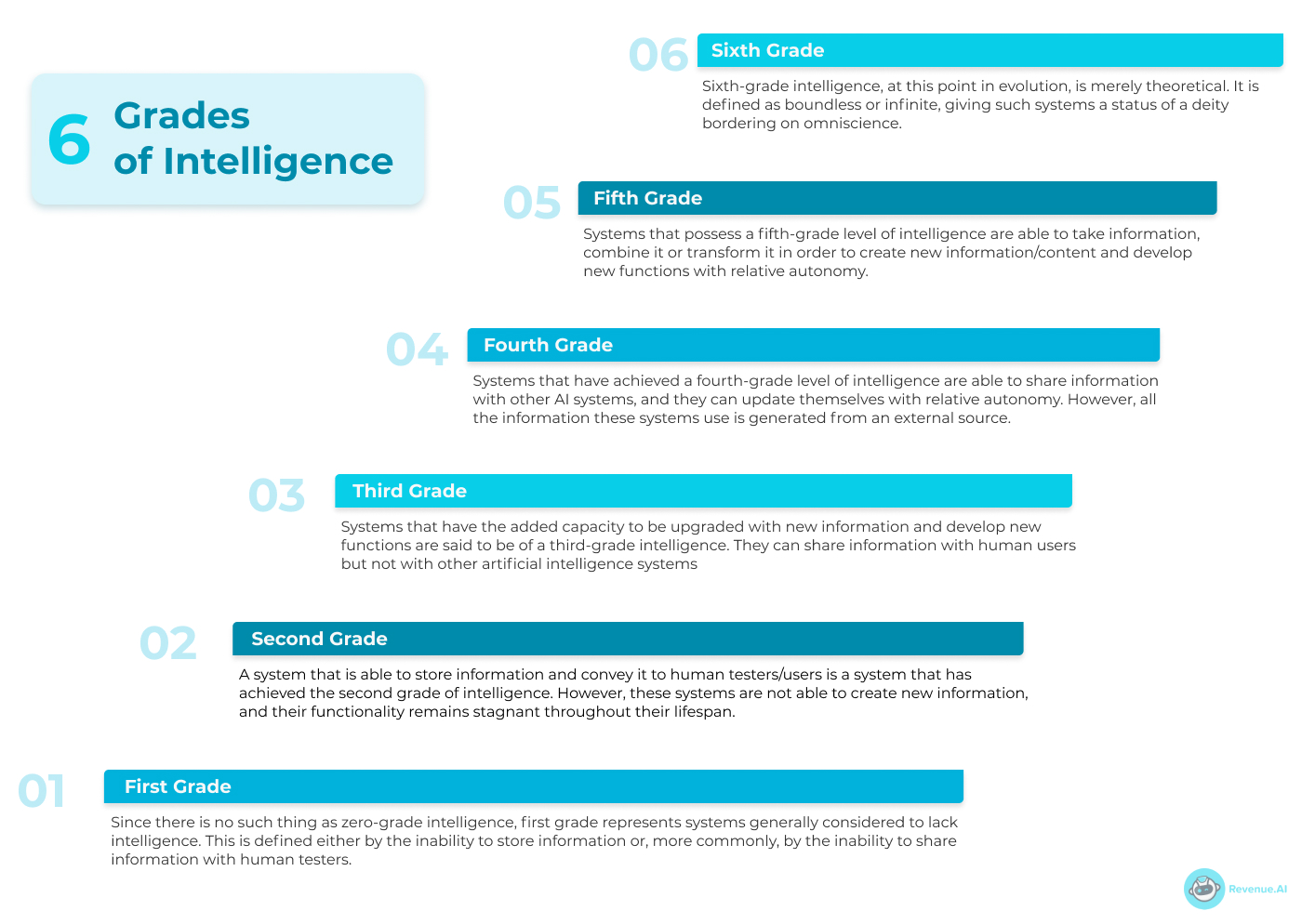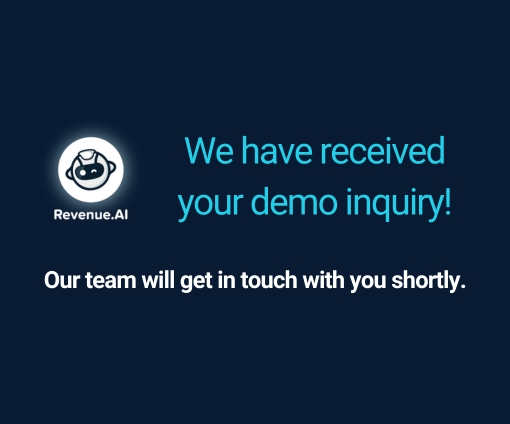The intelligence quotient of artificial intelligence programs (AI Quotient) is (or will soon be) the new indicator for corporations. Today, we’ll take a step-by-step approach to understand what is meant exactly by intelligence, how it pertains to AI systems as well as the four testable applications of intelligence and the six grades (or hierarchy) of intelligent systems.
What Is AI Quotient
Much like the intelligence quotient in humans, the AI quotient seeks to measure the ability of an artificial intelligence program to acquire, master, create, and feedback information. And much like the intelligence quotient in humans, the methodology used to test and then measure these abilities is hotly debated and continuously being refined.
- Knowledge Acquisition – how effectively and quickly can information be input into the artificial intelligence system
- Knowledge Mastery – how effectively and quickly can acquire information be used to offer solutions to problems
- Knowledge Creation – how effectively and quickly can information be used to create new content
- Knowledge Feedback – how effectively and quickly can information be output by the artificial intelligence system
How Is Intelligence Defined and Measured?
With the advent of AI technology and the array of smart products being marketed to both businesses and consumers, the notion of what genuine intelligence is and how it is measured may be somewhat confused.
Therefore, to understand the importance of AI quotient, let’s take a closer look at what exactly is meant by intelligence and the differences in the several grades of intelligence.
AI Quotient: More Than the Ability To Complete Defined Tasks
Acquiring new information requires an AI system to have a significantly powerful storage capacity. But that only scratches the surface. The AI system then needs to be able to retrieve information quickly. Speed plays an integral part in assessing a system’s AI Quotient.
Mastery of acquired information means that an AI system with a high AI Quotient is able to use the information acquired in a variety of contexts (which implies the ability to determine which contexts given information is applicable to and which contexts this information is not).
Furthermore, the information stored in an AI system must then be combined in ways that create new information (or new content). This newly created information is then stored in the AI system and combined with the previously stored information to create further new information/content, and so on and so forth.
Because AI Quotient is assessed, in part, by the system’s ability to create and feedback information, a system with a relatively high AI Quotient would need to be able to share information with human users and other AI systems. This implies the ability of the AI system to assess the relevance, pertinence, and practical application of the information it stores.
So how does the AI Quotient relate to the 6 grades of intelligence? Let’s find out below.
The 6 Grades of Intelligence

First Grade
Since there is no such thing as zero-grade intelligence, first-grade represents systems generally considered to lack intelligence. This is defined either by the inability to store information or, more commonly, by the inability to share information with human testers.
For example, inanimate objects cannot convey whatever information they may or may not possess to humans, and therefore they fall into this category.
Second Grade
A system that is able to store information and convey it to human testers/users is a system that has achieved the second grade of intelligence. However, these systems are not able to create new information, and their functionality remains stagnant throughout their lifespan.
Home appliances called “smart technology” fall into this category. For example, a smart thermostat can detect the temperature in a room and can communicate this information to the homeowner. It can also turn itself on or off depending on preset programs.
However, it is not able to acquire new information or use the information it has in any new way. It will never develop any functions other than those that it was initially designed to carry out. This is the limitation of second-grade intelligence.
Third Grade
Systems that have the added capacity to be upgraded with new information and develop new functions are said to be of a third-grade intelligence. They can share information with human users but not with other artificial intelligence systems.
Systems such as home computers or mobile phones fall into this category. While these systems may be capable of updating databases in the cloud, for example, they do not combine or re-interpret information to create new functions for themselves or for other artificial intelligence systems.
Fourth Grade
Systems that have achieved a fourth-grade level of intelligence are able to share information with other AI systems, and they can update themselves with relative autonomy. However, all the information these systems use is generated from an external source.
Systems that make up the fourth-grade intelligence category, such as cloud robotics, for example, are not able to take external information and combine or transform it to create new information or content, and they are not able to develop other functions without being updated from an external source.
Fifth Grade
Systems that possess a fifth-grade level of intelligence are able to take information, combine it or transform it in order to create new information/content and develop new functions with relative autonomy.
Human beings, as well as other natural life forms, possess this level of intelligence. And it is at this level of intelligence that we begin to see innovation and what can be qualified as creativity.
Sixth Grade
Sixth-grade intelligence, at this point in evolution, is merely theoretical. It is defined as boundless or infinite, giving such systems a status of a deity bordering on omniscience.
These hypothesized systems have an ever-expanding knowledge base and are continuously innovating. Given enough time, much like gods, systems that possess a sixth-grade intelligence will be considered all-knowing.
For a more in-depth understanding of the intelligence grades of artificial intelligence systems, you can have a look at this academic treaty on the subject.
The Prevalence of AI - A Must for Business
15 years ago, market insiders were talking about the potential of AI. Now the talk has turned to the necessity of AI. To put it simply, AI is so prevalent in businesses spanning nearly all sectors of activity that it is virtually impossible (pun intended) to compete in today’s business environment without AI.
A recent poll of top-performing companies reveals that 86% of CEOs consider AI to be mainstream technology in their place of work, over 90% of leading businesses invest in AI, and these companies expect AI to lead to at least a 25% increase in customer satisfaction.
The AI software market has grown by over 20% in the last few years. Its estimated annual value exceeds $62 billion and shows no signs of slowing down. Considering all said, the AI quotient is a topic of now, instead of future, for sure.
AI Quotient - The New Indicator for Corporations
Businesses across all sectors of activity are relying on AI to help with many key indicators:
- Customer satisfaction – by providing round-the-clock intelligent assistance from recommending products or services to handling orders and returns
- Gains in productivity – by testing and analysing countless numbers of models of production, identifying strengths and weaknesses, and suggesting effective changes in production methods and practices
- Improved efficiency, reduced operational time and operational costs – by streamlining distribution channels and evaluating workflows to eliminate redundancies
- Reduced labour costs – by automating repetitive tasks, providing customer service 24/7 through chatbots, and freeing up human talent to handle other aspects of the operation
- Monitoring and predicting changes in the market – by conducting real-time analysis of millions of data points (an impossibility even for a team of hundreds of top human employees)
- Reduction in human error – through the elimination of biases (both conscious and unconscious) as well as eliminating errors caused by stress or exhaustion
With so many key performance indicators closely tied to AI, the new indicator for corporations can simply be reduced to the strength and performance of the AI programs they use: AI quotient. To put it in plain English: the greater the AI quotient, the greater the impact on all KPIs AI plays a role in.
When leading corporations successfully implement AI technology of a fourth grade quotient, how much of a disadvantage will companies with an AI at a second or third grade intelligence be at? Will these companies still be able to survive (much less thrive) in a fast-moving highly-competitive market?
If standard AI is currently being credited with large increases in productivity, predictive capabilities, and customer satisfaction as well as a reduction in operational time, labour costs, and human error – how great of an advantage will corporations enjoy that implement the latest state-of-the-art higher AI quotient operating systems?
The Bottom Line
We have seen tremendous advancements in AI technology in recent years, and businesses across all sectors of activity are benefiting from these advancements. The benefits companies are currently reaping thanks to AI mean that it is now a near impossibility to compete without the help of a powerful AI program.
AI plays a determining role in many of the KPIs companies are concerned with. The AI quotient (the level of sophistication of the intelligence of the AI program) will soon be the new indicator for corporations as it has a ripple effect across all other KPIs.
Stay ahead of the curve. Learn how to scale AI and implement your successful AI strategy with our cloud solution and transformation enablement services. Find out more by reaching out to us today for a DEMO.






